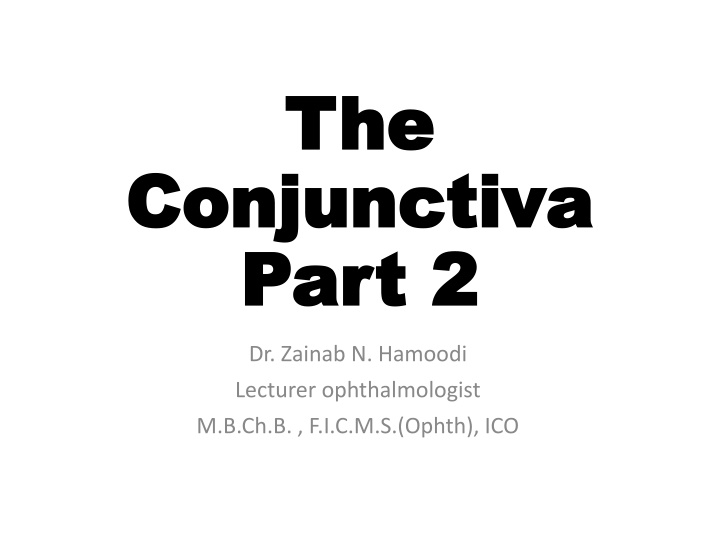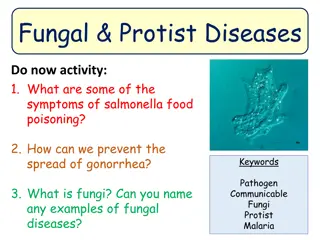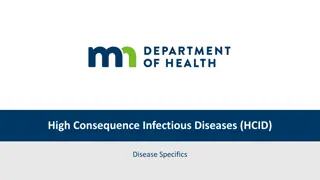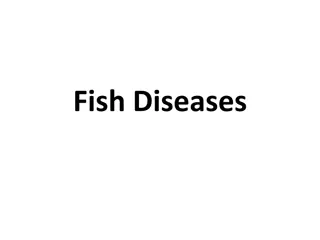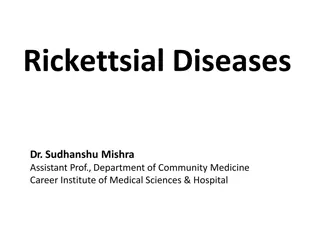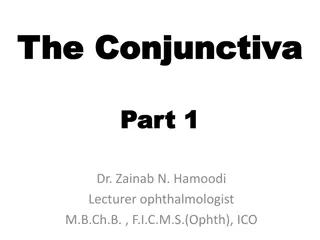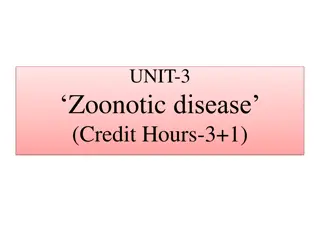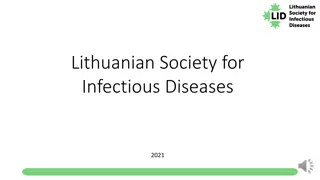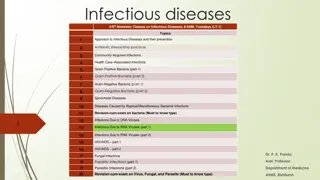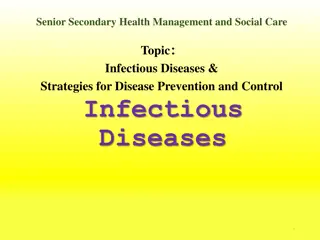Overview of Conjunctival Diseases and Their Management
Ophthalmia neonatorum is conjunctival inflammation in newborns, while allergic conjunctival diseases like seasonal and perennial conjunctivitis present with redness, itching, and watering. Vernal keratoconjunctivitis (VKC) is a recurrent condition commonly seen in warm climates, with symptoms like intense itching. Treatment includes mast cell stabilizers and antihistamines.
Download Presentation

Please find below an Image/Link to download the presentation.
The content on the website is provided AS IS for your information and personal use only. It may not be sold, licensed, or shared on other websites without obtaining consent from the author.If you encounter any issues during the download, it is possible that the publisher has removed the file from their server.
You are allowed to download the files provided on this website for personal or commercial use, subject to the condition that they are used lawfully. All files are the property of their respective owners.
The content on the website is provided AS IS for your information and personal use only. It may not be sold, licensed, or shared on other websites without obtaining consent from the author.
E N D
Presentation Transcript
The The Conjunctiva Conjunctiva Part Part 2 2 Dr. Zainab N. Hamoodi Lecturer ophthalmologist M.B.Ch.B. , F.I.C.M.S.(Ophth), ICO
Contents : Contents : Ophthalmia Ophthalmia neonatorum neonatorum Allergic conjunctivitis Allergic conjunctivitis Seasonal/perennial allergic conjunctivitis Seasonal/perennial allergic conjunctivitis Vernal Vernal keratoconjunctivitis keratoconjunctivitis (VKC) Atopic Atopic keratoconjunctivitis keratoconjunctivitis (AKC (VKC) (AKC) ) Degenerations of the conjunctiva Degenerations of the conjunctiva Pinguencula Pinguencula Pterygium Pterygium
Ophthalmia neonatorum (neonatal conjunctivitis) : Conjunctival inflammation develop within the first month of life, from infection transmitted from the mother during delivery. Timing of onset varies according to the cause: Chemical irritation first 24-48 hours Gonococcal in the first week (typically 2-3 days) Staphylococci & other bacteria end of the first week Herpes simplex (HSV usually type 2) 1-2 weeks Chlamydia 1-3 weeks
Ophthalmia Ophthalmia neonatorum neonatorum
Allergic Allergic conjunctival conjunctival diseases Seasonal/perennial allergic conjunctivitis Seasonal/perennial allergic conjunctivitis Vernal Vernal keratoconjunctivitis keratoconjunctivitis Atopic Atopic keratoconjunctivitis keratoconjunctivitis diseases Seasonal & perennial allergic conjunctivitis : Seasonal & perennial allergic conjunctivitis : S/S : S/S : redness, itching, watering, sneezing & nasal discharge . Either : Seasonal (Hay Hay fever fever eyes) eyes) symptoms are worse in spring/summer on exposure to trees & grass pollens. Perennial = causes symptoms throughout the year worse at autumn, on exposure to house dust mites/fungal allergens. Treatment : Treatment : Topical Mast cell stabilizer (MCS) or Antihistamines, or combined preparations of both. In severe symptoms oral antihistamines.
Vernal Vernal keratoconjunctivitis keratoconjunctivitis (VKC) : (VKC) : Recurrent, bilateral disease in which both IgE & cell-mediated immune mechanisms involved. Common in warm dry climates, such as the Middle East. Age of onset around 5 years, more in boys, 95% of cases usually remit by late teens, the remainder will develop atopic keratoconjunctivitis (AKC). Highly associated with other atopic conditions like asthma & eczema. Two-third of patients have family history of atopy. Peripheral blood film shows eosinophilia & high levels of IgE. VKC occurs on seasonal basis, with a peak over late spring & summer. Symptoms : Symptoms : intense itching with increased lacrimation, burning, photophobia, foreign body sensation, increased blinking is common. Thick mucoid discharge may be mistaken for bacterial conjunctivitis .
Classification: Palpebral (Tarsal) VKC There s primary involvement of upper tarsal conjunctiva. May be associated with significant corneal disease, as a result of close opposition between inflamed conjunctiva & corneal epithelium. Limbal disease Typically affects black &Asian people. Mixed VKC Has features of both palpebral & limbal disease.
Palpebral (tarsal) VKC Palpebral (tarsal) VKC
Limbal Limbal disease of VKC disease of VKC
Keratopathy Keratopathy
Atopic keratoconjunctivitis (AKC) The clinical course of AKC is characterized by: Age incidence in adults 30-50 years Follows a long history of asthma & eczema. 5% of patients have suffered from childhood VKC Tend to be chronic, unremitting with significant visual morbidity VKC is seasonal, while AKC is perennial It causes more scarring. Less responsive to treatment. Associated with significant visual morbidity
Atopic Atopic keratoconjunctivitis keratoconjunctivitis (AKC) (AKC)
Treatment of VKC & AKC is almost similar, include: General measures : General measures : allergen avoidance, cool compresses, lid hygiene Local Local treatment : treatment : MCS (mast cell stabilizers) safe for long term use Antihistamines Combined preparation of Steroids, used with caution with caution in short severe exacerbation of cojunctivitis Steroids used mainly as Topical preparations & supratarsal injection (if needed). Immune modulators, Cyclosporine as steroid sparing agent, indicated : steroids intollerance caused by adverse effects. if steroids are ineffective. Acetylcysteine = mucolytic agent to dissolve mucus plaques. + short courses courses, indicated for : significant keratopathy Systemic treatment Systemic treatment : systemic antihistamines
Conjunctival Conjunctival degenerations degenerations Pingueculum Pingueculum : : Extremely common , yellow white subepithelial deposit on bulbar conjunctiva, Nasal >Temporal , adjacent to limbus calcification Histopathology : Histopathology : Elastotic degeneration of collagen fibers of conjunctival stroma = elastosis , due to actinic damage by UV light . Treatment : Treatment : usually unnecessary unless Pinguenculitis treated with short course topical steroid. Surgical excision indicated for: cosmetic purposes large lesion causes significant irritation
Pinguencula Pterygium
Pterygium Pterygium : : Wing shaped triangular fibrovascular subepithelial ingrowth of degenerative bulbar conjunctival tissue. It grows o over side side ver the the limbus limbus onto the cornea cornea, Usually on Nasal Nasal Factors involved in pathogenesis : Factors involved in pathogenesis : Hot climate , UV light exposure, Chronic ocular surface dryness . Histopathology Histopathology Elastotic changes in vascularized subepithelial stromal collagen , similar to pinguenculum, but with different anatomy .
Treatment : Treatment : Medical :Tear substitute, Topical steroid, sunglasses use Surgical removal indications : Decreased vision by inducing astigmatism , or covering visual axis. Recurrent severe inflammation uncontrolled by topical medications Cosmetic issues Method of choice Method of choice = excision + conjunctiva autograft Simple excision 90% recurrence of a more aggressive pterygium Deep lesions over visual axis may need lamellar keratoplasty .
